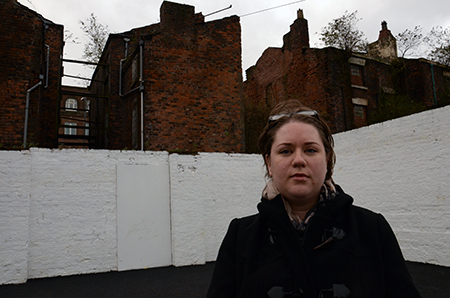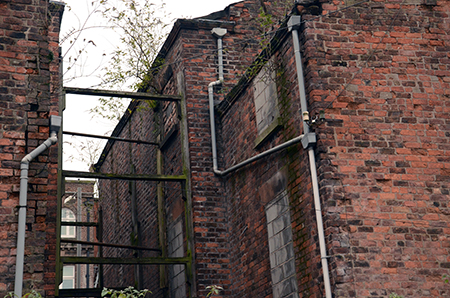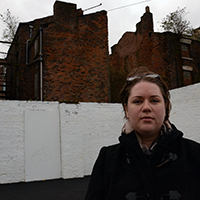 PhD student Kerry Massheder outside Liverpool’s only remaining court dwellings on Pembroke Place
PhD student Kerry Massheder outside Liverpool’s only remaining court dwellings on Pembroke Place
Liverpool was once dominated by court housing, but with only one example remaining in the city a research project is seeking first hand accounts of life in these dense domestic settings.
As the population boomed through the industrial revolution, space was at a premium and back-to-back courts spread across the newly formed urban landscape.
Poor ventilation and light
They consisted of a passageway leading from the main thoroughfare, with two and three storey houses facing each other across this narrow space. Whole families were sometimes squeezed into single rooms, while the passageways provided the only access to ventilation and light. Most were condemned as slums. Clearances that began before the start of the Second World War were completed by the 1960s, and almost all of Liverpool’s unique industrial domestic legacy was lost.
University of Liverpool PhD student, Kerry Massheder is seeking to collect first hand oral testimony from families who lived in the courts.
Kerry, from the Department of Archaeology, Classics and Egyptology, said: “There could be anything from two houses to 10 houses in each court, using whatever spare space was available. There were two types. Closed, or arched, courts were built off a quite narrow passageway and were much darker and lacked ventilation. But the open court’s entrance was the same width as the court itself and they were seen as much cleaner and of higher quality.
 The densely packed back-to-back buildings fronted on to a narrow passageway that provided the only source of ventilation and light
The densely packed back-to-back buildings fronted on to a narrow passageway that provided the only source of ventilation and light
“Cellar dwellings were quite popular in Manchester and back-to-backs were popular across the North, but courts seem to be a Liverpool thing. I think it was down to the boom in population. They could put up these quite flimsy properties very cheaply in narrow spaces.”
The only example remaining in the city, known as Watkinson’s Terrace, can be found to the rear of 35 to 39 Pembroke Place, opposite the Liverpool School of Tropical Medicine. Now in fairly poor condition, the structures were listed in 2009 due to their special architectural interest as individual survivals of court dwellings.
First hand memories
Their scarcity makes Kerry’s project even more pressing. She said: “I’m looking for first hand memories of the courts within people’s lifetimes, rather than memories of parents or relatives talking about it. I’d particularly love to hear from anybody with photographs they would be willing to share.”
Funded by the Council for British Archaeology, Liverpool’s Court Housing: An Oral History Project is supported by National Museums Liverpool (NML). It is in NML’s Museum of Liverpool where a court housing reconstruction can be found.
Kerry added: “Part of the research is to prove that oral history is a valuable source of evidence and should be right up there, and treated with the same respect, as site-based archaeology.”
If you have memories to share, please email Kerry at kerrym@liverpool.ac.uk or Kerry.Massheder@liverpoolmuseums.org.uk. You can also call on 0151 478 4033 or write to Kerry Massheder, MLK Building, Albert Dock, Liverpool, L3 4AX
